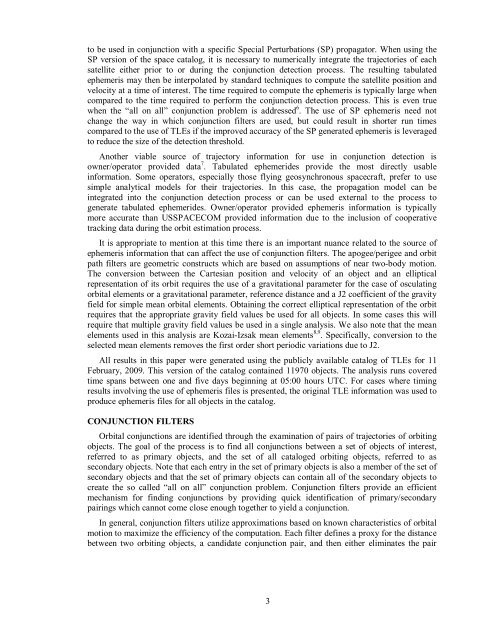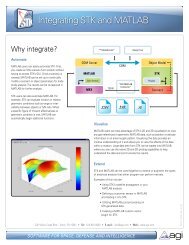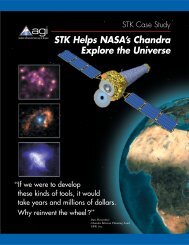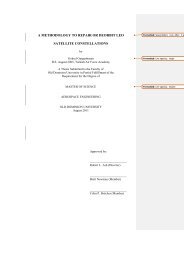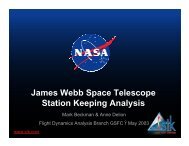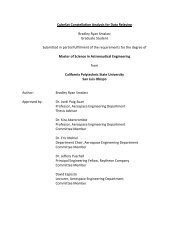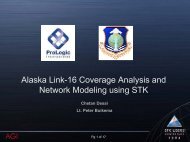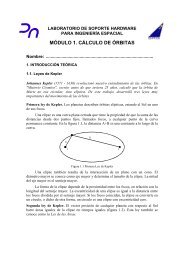Orbit Conjunction Filters Final - AGI
Orbit Conjunction Filters Final - AGI
Orbit Conjunction Filters Final - AGI
You also want an ePaper? Increase the reach of your titles
YUMPU automatically turns print PDFs into web optimized ePapers that Google loves.
to be used in conjunction with a specific Special Perturbations (SP) propagator. When using theSP version of the space catalog, it is necessary to numerically integrate the trajectories of eachsatellite either prior to or during the conjunction detection process. The resulting tabulatedephemeris may then be interpolated by standard techniques to compute the satellite position andvelocity at a time of interest. The time required to compute the ephemeris is typically large whencompared to the time required to perform the conjunction detection process. This is even truewhen the “all on all” conjunction problem is addressed 6 . The use of SP ephemeris need notchange the way in which conjunction filters are used, but could result in shorter run timescompared to the use of TLEs if the improved accuracy of the SP generated ephemeris is leveragedto reduce the size of the detection threshold.Another viable source of trajectory information for use in conjunction detection isowner/operator provided data 7 . Tabulated ephemerides provide the most directly usableinformation. Some operators, especially those flying geosynchronous spacecraft, prefer to usesimple analytical models for their trajectories. In this case, the propagation model can beintegrated into the conjunction detection process or can be used external to the process togenerate tabulated ephemerides. Owner/operator provided ephemeris information is typicallymore accurate than USSPACECOM provided information due to the inclusion of cooperativetracking data during the orbit estimation process.It is appropriate to mention at this time there is an important nuance related to the source ofephemeris information that can affect the use of conjunction filters. The apogee/perigee and orbitpath filters are geometric constructs which are based on assumptions of near two-body motion.The conversion between the Cartesian position and velocity of an object and an ellipticalrepresentation of its orbit requires the use of a gravitational parameter for the case of osculatingorbital elements or a gravitational parameter, reference distance and a J2 coefficient of the gravityfield for simple mean orbital elements. Obtaining the correct elliptical representation of the orbitrequires that the appropriate gravity field values be used for all objects. In some cases this willrequire that multiple gravity field values be used in a single analysis. We also note that the meanelements used in this analysis are Kozai-Izsak mean elements 8,9 . Specifically, conversion to theselected mean elements removes the first order short periodic variations due to J2.All results in this paper were generated using the publicly available catalog of TLEs for 11February, 2009. This version of the catalog contained 11970 objects. The analysis runs coveredtime spans between one and five days beginning at 05:00 hours UTC. For cases where timingresults involving the use of ephemeris files is presented, the original TLE information was used toproduce ephemeris files for all objects in the catalog.CONJUNCTION FILTERS<strong>Orbit</strong>al conjunctions are identified through the examination of pairs of trajectories of orbitingobjects. The goal of the process is to find all conjunctions between a set of objects of interest,referred to as primary objects, and the set of all cataloged orbiting objects, referred to assecondary objects. Note that each entry in the set of primary objects is also a member of the set ofsecondary objects and that the set of primary objects can contain all of the secondary objects tocreate the so called “all on all” conjunction problem. <strong>Conjunction</strong> filters provide an efficientmechanism for finding conjunctions by providing quick identification of primary/secondarypairings which cannot come close enough together to yield a conjunction.In general, conjunction filters utilize approximations based on known characteristics of orbitalmotion to maximize the efficiency of the computation. Each filter defines a proxy for the distancebetween two orbiting objects, a candidate conjunction pair, and then either eliminates the pair3


